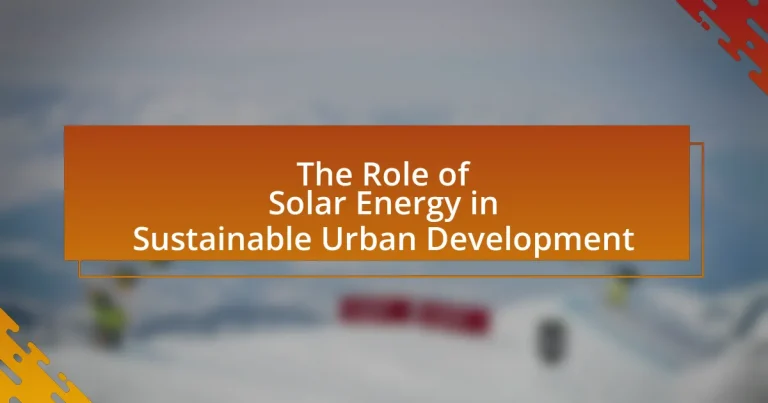Solar energy is a vital component of sustainable urban development, offering a renewable energy source that significantly reduces greenhouse gas emissions and dependence on fossil fuels. Urban areas, responsible for over 70% of global energy consumption, can leverage solar technologies to lower their carbon footprints, enhance energy resilience, and stimulate local economies through job creation in the renewable energy sector. The article explores the environmental benefits of solar energy, its impact on urban infrastructure, the challenges faced in urban settings, and best practices for integrating solar solutions into urban planning. Additionally, it discusses innovative technologies and future trends that will shape the role of solar energy in creating sustainable cities.

What is the Role of Solar Energy in Sustainable Urban Development?
Solar energy plays a crucial role in sustainable urban development by providing a renewable energy source that reduces greenhouse gas emissions and reliance on fossil fuels. Urban areas, which account for over 70% of global energy consumption, can significantly lower their carbon footprint through the integration of solar technologies. For instance, cities that implement solar photovoltaic systems can generate clean electricity, which not only powers buildings but also supports electric vehicle charging infrastructure, further promoting sustainability. Additionally, studies show that solar energy can lead to economic benefits, such as job creation in the renewable energy sector, with the U.S. solar industry employing over 250,000 workers as of 2021. This transition to solar energy contributes to energy resilience, enhances energy security, and fosters a healthier urban environment.
How does solar energy contribute to urban sustainability?
Solar energy significantly contributes to urban sustainability by reducing greenhouse gas emissions and promoting energy independence. By harnessing solar power, cities can decrease reliance on fossil fuels, which are major contributors to climate change. For instance, a study by the National Renewable Energy Laboratory found that widespread adoption of solar energy could reduce carbon dioxide emissions by up to 80 million metric tons annually in the United States alone. Additionally, solar energy systems can be integrated into urban infrastructure, such as rooftops and public spaces, maximizing land use efficiency while providing clean energy. This integration not only supports local economies through job creation in the renewable energy sector but also enhances energy resilience, making urban areas less vulnerable to energy shortages and price fluctuations.
What are the environmental benefits of using solar energy in cities?
The environmental benefits of using solar energy in cities include reduced greenhouse gas emissions, improved air quality, and decreased reliance on fossil fuels. Solar energy systems generate electricity without emitting carbon dioxide or other harmful pollutants, which significantly lowers urban carbon footprints. For instance, a study by the National Renewable Energy Laboratory found that widespread adoption of solar energy could reduce carbon emissions by up to 80% in urban areas. Additionally, solar energy contributes to energy independence, allowing cities to harness local resources and mitigate the environmental impacts associated with transporting fossil fuels.
How does solar energy impact urban infrastructure?
Solar energy significantly enhances urban infrastructure by reducing reliance on fossil fuels and lowering greenhouse gas emissions. The integration of solar panels into buildings and public spaces allows cities to generate clean energy locally, which can lead to decreased energy costs and improved energy security. For instance, cities like San Diego have implemented solar energy systems that contribute to over 20% of their energy needs, demonstrating a tangible shift towards sustainable energy sources. Additionally, solar energy systems can increase property values and stimulate local economies through job creation in the renewable energy sector.
Why is solar energy important for urban planning?
Solar energy is important for urban planning because it promotes sustainability and reduces reliance on fossil fuels. Integrating solar energy into urban environments can significantly lower greenhouse gas emissions, contributing to climate change mitigation. For instance, cities that adopt solar energy solutions can reduce their carbon footprint by up to 40%, as evidenced by studies from the International Renewable Energy Agency. Additionally, solar energy enhances energy security and resilience in urban areas, allowing cities to manage energy demands more effectively and reduce vulnerability to energy supply disruptions.
What role does solar energy play in reducing urban carbon footprints?
Solar energy significantly reduces urban carbon footprints by providing a clean, renewable source of electricity that replaces fossil fuels. Urban areas, which are major contributors to greenhouse gas emissions, can utilize solar panels on rooftops and in solar farms to generate power without emitting carbon dioxide. According to the U.S. Department of Energy, solar energy can reduce carbon emissions by approximately 80% compared to traditional energy sources. This transition not only lowers the overall carbon footprint of cities but also promotes energy independence and sustainability.
How can solar energy enhance energy security in urban areas?
Solar energy enhances energy security in urban areas by providing a decentralized and renewable power source that reduces dependence on fossil fuels and centralized energy grids. This decentralization allows urban areas to generate electricity locally, which minimizes vulnerability to supply disruptions caused by natural disasters or geopolitical tensions. For instance, cities that implement solar photovoltaic systems can produce their own energy, leading to increased resilience against power outages. According to the International Renewable Energy Agency, solar energy can significantly contribute to energy independence, with countries like Germany achieving over 40% of their electricity from solar sources during peak production times. This shift not only stabilizes energy supply but also promotes sustainable urban development by reducing greenhouse gas emissions and fostering local job creation in the renewable energy sector.
What challenges does solar energy face in urban environments?
Solar energy faces several challenges in urban environments, primarily due to space limitations, shading from buildings, and regulatory hurdles. Urban areas often have limited roof space for solar panel installation, which restricts the amount of energy that can be generated. Additionally, taller buildings can cast shadows on solar panels, significantly reducing their efficiency. Regulatory challenges, such as zoning laws and building codes, can also complicate the installation process, making it difficult for developers and homeowners to adopt solar technology. These factors collectively hinder the widespread adoption of solar energy in cities, impacting its potential contribution to sustainable urban development.
What are the regulatory barriers to solar energy adoption in cities?
Regulatory barriers to solar energy adoption in cities include zoning laws, permitting processes, and interconnection standards. Zoning laws often restrict the installation of solar panels on residential and commercial properties, limiting where solar energy systems can be placed. Permitting processes can be lengthy and complex, creating delays and increasing costs for solar projects. Additionally, interconnection standards may impose technical requirements that complicate the integration of solar energy systems with the existing electrical grid. These barriers hinder the growth of solar energy adoption, as evidenced by studies showing that streamlined permitting can significantly increase installation rates.
How do space limitations affect solar energy implementation in urban settings?
Space limitations significantly hinder solar energy implementation in urban settings by restricting the available area for solar panel installation. Urban environments often feature high-density buildings, narrow rooftops, and limited open spaces, which reduce the potential for effective solar energy capture. According to the National Renewable Energy Laboratory, urban areas can have up to 80% of their land covered by buildings and infrastructure, leaving minimal space for solar installations. This spatial constraint leads to challenges in optimizing solar panel placement, resulting in lower energy generation efficiency compared to rural areas where land is more abundant. Additionally, the orientation and shading from surrounding structures can further diminish the effectiveness of solar energy systems in cities.
How can cities effectively integrate solar energy into their development plans?
Cities can effectively integrate solar energy into their development plans by implementing policies that promote solar infrastructure, such as zoning regulations that encourage solar installations on new buildings and retrofitting existing structures. For instance, cities like San Diego have adopted a solar energy ordinance that mandates solar panels on all new residential constructions, which has significantly increased solar adoption rates. Additionally, cities can provide financial incentives, such as tax credits or rebates, to homeowners and businesses that invest in solar technology, as seen in programs across various states that have led to a substantial increase in solar capacity. Furthermore, integrating solar energy into public transportation systems, like solar-powered bus stops or charging stations for electric vehicles, can enhance the overall sustainability of urban environments. These strategies not only reduce reliance on fossil fuels but also contribute to local economic growth by creating jobs in the renewable energy sector.
What innovative technologies are enhancing solar energy use in urban areas?
Innovative technologies enhancing solar energy use in urban areas include building-integrated photovoltaics (BIPV), solar tracking systems, and energy storage solutions. BIPV integrates solar panels into building materials, allowing structures to generate energy while maintaining aesthetic appeal; for instance, the Edge in Amsterdam utilizes BIPV to achieve energy neutrality. Solar tracking systems optimize the angle of solar panels to capture maximum sunlight throughout the day, increasing energy efficiency by up to 25%. Additionally, advanced energy storage technologies, such as lithium-ion batteries, enable the storage of solar energy for use during non-sunny periods, facilitating a more reliable energy supply in urban settings. These technologies collectively contribute to the increased adoption and efficiency of solar energy in urban environments.
How do smart grids facilitate solar energy distribution in cities?
Smart grids facilitate solar energy distribution in cities by enabling real-time monitoring and management of energy flow, which optimizes the integration of solar power into the existing grid. These advanced systems utilize digital communication technology to enhance the efficiency and reliability of electricity distribution, allowing for better demand response and load balancing. For instance, smart grids can automatically adjust energy distribution based on solar generation levels and consumer demand, reducing energy waste and improving overall grid stability. Additionally, they support decentralized energy production, allowing homes and businesses with solar panels to contribute excess energy back to the grid, thereby promoting a more sustainable urban energy ecosystem.
What role do energy storage solutions play in urban solar energy systems?
Energy storage solutions are crucial in urban solar energy systems as they enable the efficient use of generated solar power by storing excess energy for later use. This capability addresses the intermittent nature of solar energy, allowing urban areas to maintain a stable energy supply even when sunlight is not available. For instance, according to the U.S. Department of Energy, integrating energy storage with solar systems can increase the overall efficiency and reliability of urban energy grids, facilitating a smoother transition to renewable energy sources. Additionally, energy storage can help reduce peak demand on the grid, leading to lower energy costs and enhanced grid resilience.
What are the best practices for promoting solar energy in urban development?
The best practices for promoting solar energy in urban development include integrating solar technologies into building designs, implementing supportive policies and incentives, and fostering community engagement. Integrating solar technologies, such as photovoltaic panels and solar thermal systems, into new and existing buildings maximizes energy efficiency and reduces reliance on fossil fuels. Supportive policies, like tax credits and zoning regulations that favor solar installations, encourage investment and adoption of solar energy. Community engagement through educational programs and local initiatives raises awareness and acceptance of solar energy, leading to increased participation in solar projects. These practices collectively enhance the viability and attractiveness of solar energy in urban settings, contributing to sustainable urban development.
How can community engagement improve solar energy projects in cities?
Community engagement can significantly improve solar energy projects in cities by fostering local support, enhancing project design, and ensuring equitable access to benefits. Engaged communities are more likely to advocate for solar initiatives, leading to increased funding and policy support. For instance, a study by the National Renewable Energy Laboratory found that community involvement in solar project planning can lead to a 20% increase in project acceptance rates. Additionally, when residents participate in the design process, projects can be tailored to meet specific local needs, resulting in higher efficiency and satisfaction. Engaging diverse community members also ensures that the benefits of solar energy, such as job creation and reduced energy costs, are distributed equitably, addressing social and economic disparities.
What incentives can local governments provide to encourage solar energy adoption?
Local governments can provide financial incentives such as tax credits, rebates, and grants to encourage solar energy adoption. These incentives reduce the upfront costs associated with solar installations, making them more accessible to homeowners and businesses. For instance, the federal solar investment tax credit allows for a 26% deduction on the cost of solar systems, which local governments can complement with additional local tax incentives or direct financial assistance programs. Studies have shown that such financial incentives significantly increase solar adoption rates; for example, a report by the National Renewable Energy Laboratory indicated that states with robust incentive programs saw solar installations grow by over 50% annually.
What future trends can we expect in solar energy and urban development?
Future trends in solar energy and urban development include increased integration of solar technologies in building designs and the rise of smart cities utilizing solar power for energy efficiency. Urban areas are increasingly adopting solar panels on rooftops and facades, driven by policies promoting renewable energy and sustainability. According to the International Energy Agency, solar energy capacity is expected to grow significantly, with projections indicating that solar could become the largest source of electricity by 2030. Additionally, urban planning is evolving to incorporate solar energy systems in public infrastructure, such as solar streetlights and solar-powered public transport, enhancing energy resilience and reducing carbon footprints.
How can urban residents maximize the benefits of solar energy?
Urban residents can maximize the benefits of solar energy by installing solar panels on rooftops and utilizing solar energy storage systems. Rooftop solar panels can generate electricity, reducing reliance on grid power and lowering energy bills; for instance, a typical residential solar system can save homeowners approximately $10,000 to $30,000 over 20 years, depending on local energy costs and incentives. Additionally, integrating solar energy storage systems allows residents to store excess energy generated during the day for use during peak hours or outages, enhancing energy independence. Furthermore, participating in community solar programs can provide access to solar energy for those unable to install panels, thereby expanding the benefits of solar energy to a broader population.


